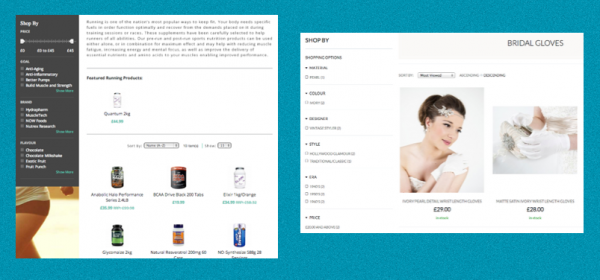Best eCommerce Websites: Birchbox Skyrockets with Subscription Retail
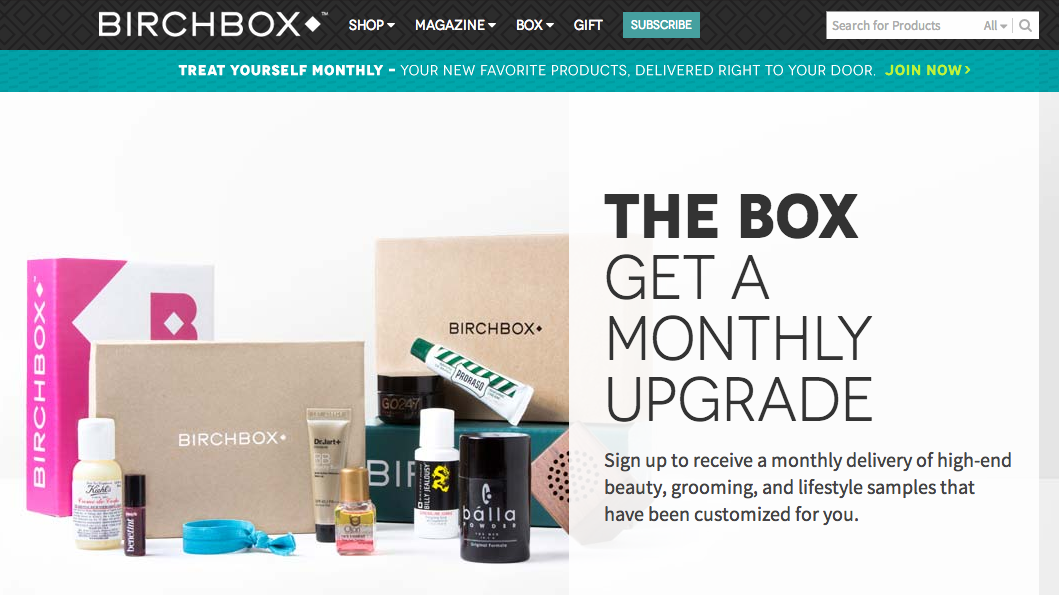
Birchbox is one of the most successful models in the subscription eCommerce market and is one of the best eCommerce websites to watch if you are building a similar retail model.
Subscription-based retail offers some great advantages, not least of which is a regular monthly income and the ability to build a loyal customer base. But being able to service those customers and keep them excited about your products each and every month is one of the biggest challenges these online retailers face.
In the past year, Birchbox’s U.S traffic alone has more than doubled from 111,917 monthly visitors in February 2013 to 334,357 in February 2014. This indicates that initial visitors are returning each month, and these visitors are also talking about the site amongst their social networks which is drawing in even more new visitors monthly.

SOURCE: Compete Site Analytics
So Birchbox has clearly found a good balance between providing a compelling subscription service to new customers and intriguing existing customers enough to continue their subscriptions as well. What’s more, the Birchbox subscription model does this via sending product samples to its subscription members, rather than fully-fledged merchandise (this means Birchbox can offer a subscription pricing of around $10 per month, but risks customer dissatisfaction if the samples seem a little light).
Who can learn from the Birchbox model?
- Online retailers wanting to establish a subscription-based commerce model
- Online retailers who want to add to their services by offering a subscription-based offering
- Service providers and online businesses who use a monthly subscription payment approach
Branding and PR
1. Go Lean
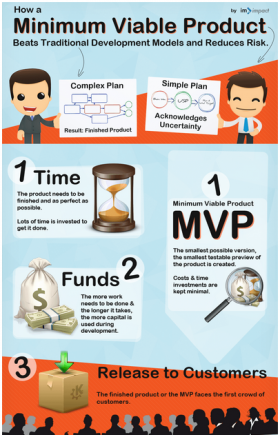 In the past, retailers needed a fairly large amount of capital in order to create their business: leasing a site; paying for initial merchandise; printing and distributing promotional materials; paying staff; and purchasing equipment like cash registers and shelving. The internet and cloud-based services have reduced these initial market entry costs, giving rise to the lean business model.
In the past, retailers needed a fairly large amount of capital in order to create their business: leasing a site; paying for initial merchandise; printing and distributing promotional materials; paying staff; and purchasing equipment like cash registers and shelving. The internet and cloud-based services have reduced these initial market entry costs, giving rise to the lean business model.
A lean model starts with a minimum viable product (MVP) and tries to learn and pre-empt customer needs based on the market reaction to this initial offering (see diagram at right, from infographic by imimpact). With this sort of bootstrapping approach, you are testing how to build customer loyalty and provide quality products with an actual audience of end users who are already getting some benefits from your product or service offering.
That’s how Birchbox built their business. Speaking with tech website Mashable, Co-Founder Katia Beauchamp explained that at first, the startup team dreamt big around how they wanted to use online retail to change the way women shop. But that was too daunting a business goal to get started working on. Beauchamp told Mashable: “We said, ‘We’re going to take a small version of our vision and launch it with the small amount of money that we have and see if people like us.’ And that really empowered us and helped us see the minimum viable product for us, and that was such an important way for us to feel comfortable personally with taking a leap of faith and to really get our brand and our customers excited.”
How this is useful
- As a business owner, you are excited about the potential success of your business, but this can be paralyzing as well. Start with a handful of customers and seek to serve them well, and you will quickly learn how to improve your online retail business every day.
- Take your first customers seriously and build communication relationships with them so you can find out what it is about your business that keeps them buying from you. When you know that, you can scale it for others.
- Check out some of the lean business guides like the Lean Entrepreneur and the Entrepreneur’s Guide to Customer Development.
2. Use the inverted pyramid formula for your home page
In news reporting and blogging, the main formula used for writing articles is the inverted pyramid. In tradition newspaper circles, it is often said “Don’t bury the lede.” The idea is that readers could move on to the next article at any time, so it is crucial to give them the most important information straight up, offering more detailed information later for those who want to dig a little deeper into an issue.
You can see how Birchbox has used the inverted pyramid approach on their home page:
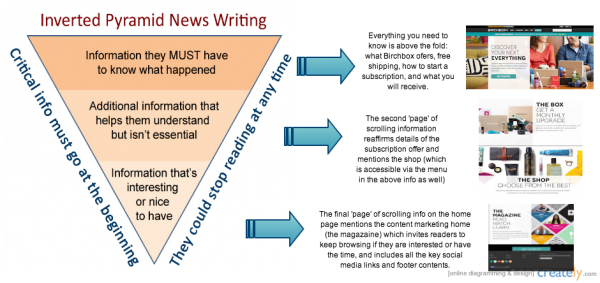
(Note: Left-hand image sourced from Anytown College)
How this is useful
- When designing your home page, structure your content around the inverted pyramid rule. Even if your page is longer than one screen size, make sure that all of the essential information is immediately viewable when readers open your home page.
- Use the second section (first below the fold) to reassert your key offerings and to provide a little more information: in this case, your subscription service and your main store.
- Use the third section of your home page to encourage readers to continue browsing, for example, by referencing specific product sections or your blog or other content pages.
3. Use your head(er): Be consistent
In a similar way to how AutoParts Warehouse uses their masthead, Birchbox makes sure all of the information you need is included in the header menu rows of their website:
- Login link
- Shopping cart details
- Shipping trust signal
- Store link
- Subscription offer link
- Sign up button.
How this is useful
- Make it easy for your readers to navigate around your site: use a consistent header with menu so that your visitors always know how to jump to the areas they most want.
- Make it easy for visitors to sign up wherever they are on your site by always including a sign up button in your header.
- Test the color you use for your signup button and continue A/B testing until you have a clear winner for which you get more signups than with any other color.
Product Range
4. Take a co-marketing attitude with your suppliers
To start offering their subscription service, the Birchbox founders wrote to a range of cosmetics suppliers and discussed their idea. They told the suppliers of their intention to create a sample box service and offered to share their data findings. They approached the suppliers by making it clear this was an idea they wanted to test in the market, and that — if successful — it would create a qualified set of market leads who were interested in testing the suppliers’ products.
How this is helpful
- Be up front with your suppliers about testing your subscription model.
- Recognize that your subscription customers are the equivalent of qualified sales leads from your supplier’s perspectives, so you may represent a valuable sales funnel to your product suppliers.
- Make sure you can aggregate your customer data in a way that shows the level of interest in the supplier’s products and be ready to share any user generated content with them that gives them insights into how customers react to their products.
5. Co-market some more!
Since Birchbox have been able to build these relationships with suppliers, they are now able to leverage those relationships further by providing exclusive products in their store. (This is a little similar to how Cherrybrook have been able to build supplier relationships with a couple of industry leaders in the dog show and dog grooming niche to become an exclusive sales channel for highly reputable brands in that niche.)
While this may not be available to newer online retailers who are yet to build a strong relationship with a supplier, it doesn’t hurt to occasionally ask if there are over-stocked items that could be made available to your customers in tandem with the next subscription box deliveries.
How this is useful
- Work to build trusting relationships with your suppliers so that you can offer your customers exclusive products or discounted deals from the brands you work with.
- Aim to align exclusive and discounted offers on your online retail website with deliveries of subscription boxes that reinforce the product ranges you are trying to promote.
- Wherever possible, start to use an annual planning calendar to begin locking in discounted deals, exclusive offers and the matching subscription contents so that you can move a few steps ahead of your current workload.
eCommerce Platform
6. Use product catalog platforms wisely
While not stated on the website, it appears that Birchbox uses the Magento eCommerce platform to manage its product catalog. Here is how their product category page looks:
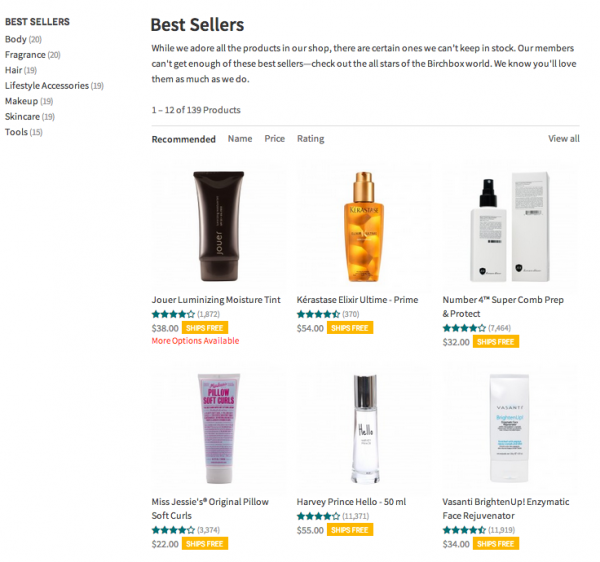
Here are two other websites that do use Magento. You can see how they have a similar template layout, with menu on the left and space for an opening paragraph of text and then a grid layout of products, on the right:
How this is useful
- Consider what conventions are most popular in displaying store products. While it can be exciting to trial new design ideas, there is also a lot of wisdom in using templates provided by eCommerce platform solutions who have tested most accessible design layouts with customers across a range of industries.
- Another concept in the lean business model is to focus on your unique selling position: in this case, your store and niche you are working in. So it makes sense to use an off-the-shelf product for store and product catalog layout. There are also a range of new services starting up specifically designed for the subscription eCommerce business model.
7. Choose a 3PL when you are ready to scale
Using a drop shipping service can be a difficult starting point when beginning to offer a subscription service. Drop shipping needs a certain amount of monthly sales to scale effectively for the subscription commerce model. And one of the key selling points of offering a subscription service is achieved through consistent branding. Birchbox for example, sends their boxes with a printed card listing each sample item included in the box and with instructions on how to enjoy each item.
Roger Fuentes provides a Quora question and answer comment on Birchbox’s drop shipping model. He presumes the online retailer does use a 3PL supplier and provides a demonstration of the costs that are incurred:
- $2.50 to process each order
- $0.10 per item included in the subscription box, including printed materials such as product item lists and instruction cards
- Monthly account management fee, including Monthly IT management fee, warehousing/storage per pallet, return handling fee, and many other fees
- Shipping costs, using something like FedEx SmartPost (averaging ~$7.50 for a package weighing ~2 lbs.)
Fuentes also says that “Most 3PLs will require some kind of monthly minimum order (~$2,000 per month in total costs)”.
How this is useful
- Be prepared to package and mail your initial subscription boxes to customers for the first few months as you test viability and create a customer base.
- Research 3PL shipping options thoroughly to find the best deal.
- Use your first few months to find ways to template and automate as much of your process as possible: product item cards with descriptions, branding stickers, tracking customers and organizing delivery schedules. Work to make sure as much of your process is as streamlined as possible before outsourcing to a 3PL supplier so you are confident you are minimizing overheads.
Customer Experience
8. Let customers build their social profiles
When new users first log in to Birchbox, they are invited to create a personal profile, similar to a social media account. This way, Birchbox can provide a more personalized subscription box of product samples suited to the specific interests of the subscriber. But it also lets Birchbox collect a wealth of information that can be aggregated and shared with suppliers (Birchbox is clear in their privacy policy that they do not share personal information about individuals.) So when approaching suppliers or coordinating special deals and offers, Birchbox can prove to the industry that they have a qualified set of customers who ideally match the supplier’s product range. The subscribers end up getting better products that better match what they want, so it is a win-win situation.
How this is useful
- Create forms or embed customer visitor management data analytics in such a way that you can begin to build personal profiles of each of your customers and aggregate this data on a regular basis to better understand the customer segments that are connecting with your site.
- As you grow, try and offer three to six variations of your subscriber box if following the sample model, with each variation suited to key characteristics of your audience. This might start as simply as ‘female’ and ‘male’ shoppers, or by age range. Over time, you might see more meaningful target market segments emerge within the data that your customers share with you.
9. Use customer data to build personas
In addition to the customer profiles that subscribers build, Birchbox reviews their overall site analytics to identify what products and items their visitors are most interested in. From this data, Birchbox has been able to create content such as “top trends” catalog pages.
How this is useful
- Use your data to scale your sales. Dig deep into what your site visitors are reviewing and what products are most popular, and repackage these items as part of monthly content around trends and top picks.
- Use aggregated data to build stronger relationships with suppliers, and where specific product ranges are most popular, seek to offer exclusive deals and discounts with suppliers for access to products that match your customers’ interests.
10. Reward social media engagement
In reviews of Birchbox on sites like My Subscription Addiction, one of the most loved features of the Birchbox experience is the generous rewards scheme that is offered loyal customers. Shoppers gain points from referring friends, and personal referrals are one of the most effective ways of generating new customers in both online and offline retail. In addition, they reward customers that use social media to share their Birchbox subscription purchases. For example, an active video-blogging (vlogging) community has risen up, with customers often videoing their reaction to a new Birchbox delivery and posting it on youtube. This sort of user-generated content is invaluable to Birchbox when showing suppliers how their customers are engaging with the suppliers’ products, but is also the sort of viral, community led media engagement that cannot be bought, but that has a powerful customer multiplier effect.
How this is useful
- Create ways for your customers to share their shopping experience on social media. For example, BaubleBar has done this very successfully using Instagram.
- Link user generated content with your rewards program. Offer points and incentives for customers who share their experience (good or bad) on social media.
- Highlight user generated content on your Twitter feed and in your blog. Birchbox has been able to include social media ratings directly into their product catalog as a trust signal.
11. Encourage browsability

Birchbox also uses this wealth of data to repackage their content in ways that encourage more browsing. While search options and latest deals are important web functions to include to make your site accessible and allow visitors to quickly navigate to the products they will purchase, online stores must also provide a rewarding and entertaining aspect that encourages visitors to browse, even if they do not have a specific product purchase in mind. Birchbox has created content sections to encourage site visitors to explore the product catalog at their own leisure. Some sections — like the Top 10 lists for product categories and the top trends sections — use social proof and trending data as a way to encourage visitors to ‘keep up’ with other shoppers. Other sections have an interactive element that helps visitors navigate and browse without knowing specifically what they want. For example, a store section encourages visitors to choose their ‘beauty style’ (classic, trendy, low-maintenance, or adventurous) in order to surface specific product options best suited to their tastes.
How this is useful
- Use the data from your profiles and from visitor behavior analytics to help determine how you can repackage your product catalog and content in new categories to encourage further browsing. Try to pull back from product categories, and instead focus on the personas that you are identifying as being important customer target segments for your site.
- Offer opportunities for visitors to feel a sense of community by including top ten lists, social media reviews and mentions, and other category listings that share the experiences of the site visitors and leverage social proof.
- Maintain a content marketing strategy to ensure monthly growth for your online store.
Will You Be Ranked One of the Best eCommerce Websites of Tomorrow?
Birchbox is providing that there is a demand for subscription box online retail. Whether it be by offering samples — like the Birchbox model — or a curated range of ‘discovery’ products that encourage subscribers to continue shopping online, there are many opportunities to build a loyal customer base and to strengthen relationships with suppliers. Starting small and building a service your customers will love, engaging with your subscribers on social media, and strengthening the reasons why subscribers should explore more of your store are three of the most important eCommerce techniques that Birchbox have mastered through their subscription offering. Can you build a similar model for your subscription retail offering? Share your experiences with us in the comments below.
Tagged 3PL, Birchbox, co-marketing, customer data, drop shipping, sample boxes, subscription boxes, subscription commerce, subscription retail

